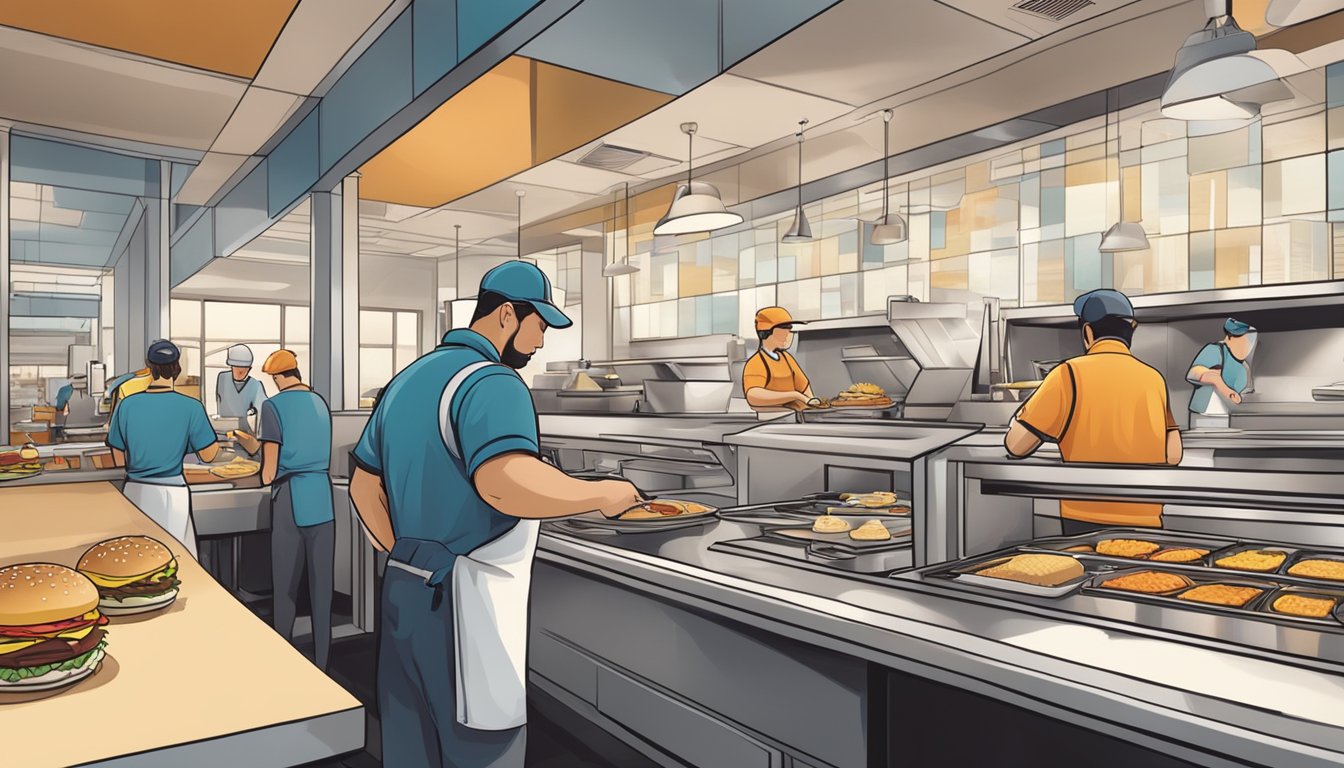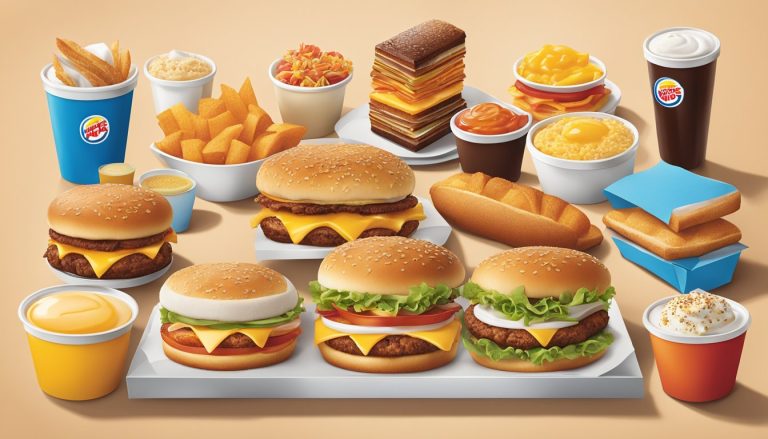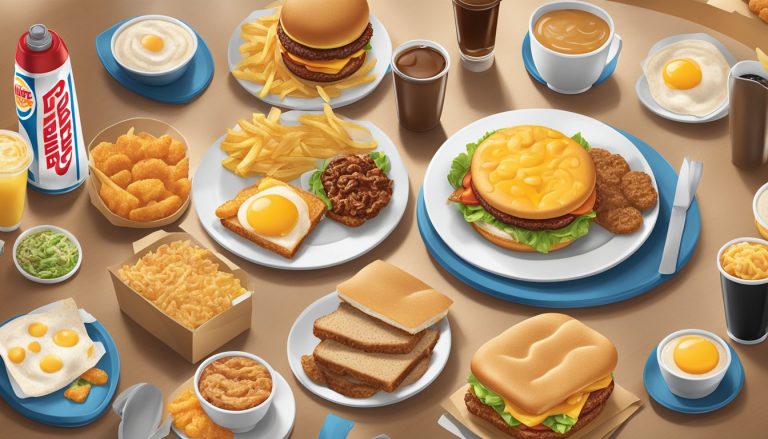Burger King’s breakfast menu has long been a staple for early morning commuters and weekend brunch enthusiasts. While customers eagerly await their sausage biscuits and hash browns, behind the scenes, fast food workers face significant labor challenges. The fast food industry’s labor practices have come under increased scrutiny in recent years, with concerns ranging from low wages to unstable scheduling.
Fast food chains, including Burger King, have grappled with high turnover rates and staffing shortages. These issues have prompted some companies to explore long-term solutions, recognizing that quick fixes are insufficient to address systemic problems. Worker advocacy groups have pushed for improved conditions, higher pay, and more consistent schedules.
The fight for better working conditions in fast food restaurants has roots stretching back decades. From early organizing efforts in the 1980s to the modern “Fight for 15” movement, workers have consistently sought to improve their circumstances. As the industry continues to evolve, the balance between profitability and fair labor practices remains a key issue for fast food chains and their employees.
Burger King’s Place in the Fast Food Industry

Burger King has been a major player in the fast food industry for decades. The company’s innovative approach to menu items and marketing has helped it maintain a significant presence in a competitive market.
History of Burger King
Burger King was founded in 1953 in Jacksonville, Florida. Initially named Insta-Burger King, the restaurant quickly gained popularity for its flame-grilled burgers. In 1967, the company was acquired by Pillsbury and began its rapid expansion.
The introduction of the Whopper in 1957 marked a turning point for Burger King. This signature sandwich became an iconic menu item, helping to differentiate the brand from competitors.
Burger King’s international expansion began in the 1960s, with the first international location opening in Canada. By the 1970s, the chain had established a presence in Europe and Asia.
Burger King Market Share
Burger King holds a significant share of the global fast food market. As of 2024, it ranks as the second-largest hamburger chain worldwide, behind McDonald’s.
In the United States, Burger King’s market share fluctuates between 15-20% of the fast food burger segment. The company has over 18,000 locations globally, with a strong presence in North America, Europe, and Asia.
Burger King’s market position is bolstered by its focus on value offerings and menu innovation. The chain regularly introduces limited-time items to attract customers and compete with other fast food giants.
Competitive Landscape
Burger King faces stiff competition in the fast food industry. Its primary rivals include:
- McDonald’s: The industry leader, with a larger global footprint and market share.
- Wendy’s: Known for its square patties and fresh ingredients.
- Taco Bell: A major player in the Mexican-inspired fast food segment.
- KFC: Dominating the fried chicken market.
Burger King differentiates itself through its flame-grilled burgers and customizable menu options. The “Have It Your Way” slogan emphasizes this commitment to personalization.
The company has also embraced technology, implementing mobile ordering and delivery services to compete with both traditional fast food chains and emerging food delivery platforms.
Analyzing Burger King’s Breakfast Offerings
Burger King’s breakfast menu has evolved significantly since its introduction, offering a range of options to compete in the morning fast food market. The chain has focused on creating unique items while also providing familiar breakfast staples.
Breakfast Menu Evolution
Burger King entered the breakfast scene in the late 1970s, following McDonald’s lead. The initial menu featured basic items like eggs, bacon, and toast. Over time, BK expanded its offerings to include more diverse options.
In the 1980s, Burger King introduced the Croissan’wich, a breakfast sandwich served on a croissant. This item became a signature breakfast offering and remains popular today.
The menu continued to grow, adding items like French toast sticks, breakfast burritos, and pancakes. BK also introduced healthier options such as oatmeal and fruit smoothies to cater to changing consumer preferences.
Popularity of Breakfast Options
Burger King’s breakfast menu has gained a loyal following, with several items standing out as fan favorites. The Croissan’wich remains a top seller, appreciated for its flaky texture and variety of fillings.
French toast sticks have become an iconic BK breakfast item, appealing to both adults and children. Their portability and sweet flavor make them a popular choice for on-the-go customers.
BK’s breakfast burrito has also gained traction, offering a hearty option for those seeking a more substantial morning meal. The chain’s coffee has improved over the years, becoming a key component of its breakfast success.
Comparative Analysis with Competitors’ Breakfast
Burger King’s breakfast offerings compete directly with other fast food giants, particularly McDonald’s and Wendy’s. While McDonald’s holds a larger market share, BK has carved out its niche with unique menu items.
BK’s use of croissants for sandwiches sets it apart from competitors who primarily use biscuits or English muffins. This point of differentiation has helped BK attract customers looking for a slightly more upscale breakfast option.
In terms of menu variety, Burger King offers a comparable range to its competitors. However, it lacks some of the healthier options found at chains like Starbucks or Dunkin’.
| Chain | Signature Breakfast Item | Unique Offering |
|---|---|---|
| Burger King | Croissan’wich | French Toast Sticks |
| McDonald’s | Egg McMuffin | McGriddles |
| Wendy’s | Breakfast Baconator | Frosty-ccino |
The Labor Practices in the Fast Food Industry

Fast food labor practices have evolved from assembly line systems but face ongoing challenges. Workers contend with low wages, limited benefits, and high turnover rates, while major chains grapple with staffing shortages and union pressures.
Current Labor Challenges
Fast food chains struggle to attract and retain workers. The industry faces a severe labor shortage, with many positions remaining unfilled. Low wages and minimal benefits contribute to high turnover rates.
Some restaurants have turned to automation to address staffing issues. Self-service kiosks and mobile ordering systems reduce the need for front-line employees. However, these solutions can’t fully replace human workers, especially in food preparation roles.
Unions are making inroads in the traditionally non-unionized fast food sector. Workers are organizing to demand better pay, more consistent schedules, and improved working conditions.
The Impact on Workers
Fast food employees often contend with unpredictable schedules and limited hours. This instability makes it difficult to plan personal lives or secure second jobs. Many workers struggle to make ends meet on fast food wages alone.
Benefits are typically minimal in the industry. Health insurance, paid time off, and retirement plans are rare, especially for part-time staff. This lack of benefits can lead to financial insecurity and health challenges for workers.
Career advancement opportunities are limited for many fast food employees. While some chains offer management training programs, the majority of positions remain entry-level with little room for growth.
Labor Practices at Major Competitors
McDonald’s has faced criticism for its labor practices but has made efforts to improve. The company raised its minimum wage at corporate-owned locations and expanded educational benefits for employees.
Wendy’s implemented a “People First” initiative, focusing on employee development and well-being. The program includes leadership training and opportunities for advancement within the company.
Burger King’s parent company, Restaurant Brands International, has committed to increasing diversity in its workforce and leadership. They’ve also pledged to improve working conditions and provide more comprehensive training programs.
Chipotle offers more competitive benefits, including tuition reimbursement and paid sick leave. These policies aim to reduce turnover and attract higher-quality candidates in a tight labor market.
Marketing Strategies for Breakfast Menus
Fast food chains employ targeted campaigns to boost breakfast sales. Digital platforms and consumer engagement play crucial roles in promoting morning offerings.
Burger King’s Marketing Campaigns
Burger King launched innovative promotions to capture the breakfast market. The BK Cafe platform introduced upgraded beverages, targeting morning commuters. This move mirrors McDonald’s McCafe concept, aiming to attract coffee enthusiasts.
A standout initiative was Burger King’s coffee subscription program. For $5 per month, customers gained access to unlimited coffee. This strategy encouraged repeat visits and brand loyalty during breakfast hours.
Burger King also leveraged collaborations to enhance its breakfast appeal. Partnerships with popular brands or local organizations helped create buzz around morning menu items.
The Role of Digital Marketing
Digital channels are integral to breakfast menu promotions. Social media managers craft engaging content to showcase morning offerings. Eye-catching images and videos of breakfast items populate platforms like Instagram and TikTok.
Content marketing strategies include blog posts and digital magazines highlighting nutritional benefits of breakfast options. Email campaigns deliver personalized offers and remind customers about breakfast specials.
Mobile apps play a key role, offering exclusive breakfast deals and allowing easy ordering. Push notifications prompt users about limited-time breakfast promotions.
Analyzing Consumer Engagement
Data analytics drive breakfast marketing decisions. Fast food chains track metrics such as click-through rates on breakfast-related social posts and app engagement during morning hours.
Customer feedback on breakfast items is closely monitored. Reviews and ratings help refine menu offerings and marketing messages.
A/B testing of breakfast promotions allows chains to optimize campaigns. Factors like timing, messaging, and visuals are adjusted based on performance data.
Loyalty program data reveals breakfast ordering patterns. This information shapes personalized marketing efforts and menu development.
Exploring Digital Publishing in the Fast Food Industry

Fast food chains increasingly leverage digital publishing to reach customers and enhance brand visibility. This shift has revolutionized marketing strategies, content creation, and customer engagement in the industry.
Content Types and Marketing Collateral
Fast food brands utilize diverse digital content formats to captivate audiences. Flipbooks showcase menu items and promotions with interactive features. Fullscreen sharing enables immersive experiences on mobile devices. QR codes on packaging link to digital menus and exclusive offers.
Marketers create blog posts highlighting new menu items and company initiatives. Webinars educate franchisees on best practices. Infographics visualize nutrition information and sourcing practices.
Digital publishing platforms like Issuu facilitate easy creation and distribution of this content. Integrations with tools such as Canva, Adobe Express, and InDesign streamline the design process for marketers and designers.
Leveraging Platforms for Brand Visibility
Social media plays a crucial role in fast food digital publishing strategies. Brands maintain active presences on Instagram, TikTok, and Twitter to share promotions and engage with customers.
YouTube channels feature behind-the-scenes content and recipe videos. Facebook groups foster community among brand enthusiasts. LinkedIn showcases corporate initiatives and recruits talent.
Email marketing campaigns deliver personalized offers and drive app downloads. Branded mobile apps provide exclusive content and loyalty rewards. Geo-targeted push notifications alert nearby customers to limited-time promotions.
The Effectiveness of Short-Form Content
Short-form content dominates fast food digital publishing efforts. TikTok videos and Instagram Reels showcase menu hacks and limited-time offers. Twitter posts spark conversations with witty one-liners and trending topics.
Stories on Instagram and Facebook provide fleeting glimpses of new products. Snapchat filters add a playful element to brand interactions. Six-second YouTube bumper ads capture attention before longer videos.
This bite-sized content aligns with modern attention spans and mobile consumption habits. It drives engagement, increases brand recall, and encourages sharing among younger demographics.
Assessing Food Quality and Customer Satisfaction

Food quality and customer satisfaction are critical factors in the fast food industry. They directly impact customer retention, brand loyalty, and overall business success.
Importance of Food Quality in Customer Retention
Food quality plays a crucial role in retaining customers in the fast food sector. Consistent taste, freshness, and presentation are key elements that influence repeat visits. A study found a positive relationship between perceived service quality and customer satisfaction in fast food restaurants.
Burger King’s focus on flame-grilled burgers sets it apart from competitors. The Whopper, their signature sandwich, remains a popular choice due to its distinct flavor profile. However, maintaining quality across all menu items is essential for customer loyalty.
For breakfast offerings, factors like hot coffee, fresh ingredients, and quick service are vital. Burger King’s breakfast menu aims to meet these criteria with items like croissant sandwiches and hash browns.
Benchmarking Burger King’s Offerings
Benchmarking Burger King’s food quality against competitors helps identify areas for improvement. Key metrics include taste, portion size, nutritional value, and consistency across locations.
Burger King’s lunch menu, centered around the Whopper, competes well in taste tests. However, the chain faces challenges in perceived healthiness compared to some rivals.
The breakfast menu has shown improvements, with expanded coffee options and new sandwich varieties. Yet, it still trails some competitors in terms of perceived freshness and variety.
Roles of Feedback and Continuous Improvement
Customer feedback is invaluable for maintaining and improving food quality. Burger King uses surveys, social media monitoring, and in-store feedback to gauge customer satisfaction.
Quick response to negative feedback is crucial. For instance, addressing issues with cold food or incorrect orders promptly can turn a negative experience into a positive one.
Continuous improvement involves regular menu updates, ingredient sourcing reviews, and staff training. Burger King has implemented programs to enhance food preparation techniques and customer service skills.
Incorporating customer suggestions into new menu items or improvements can boost satisfaction. This approach shows customers that their opinions are valued and acted upon.




